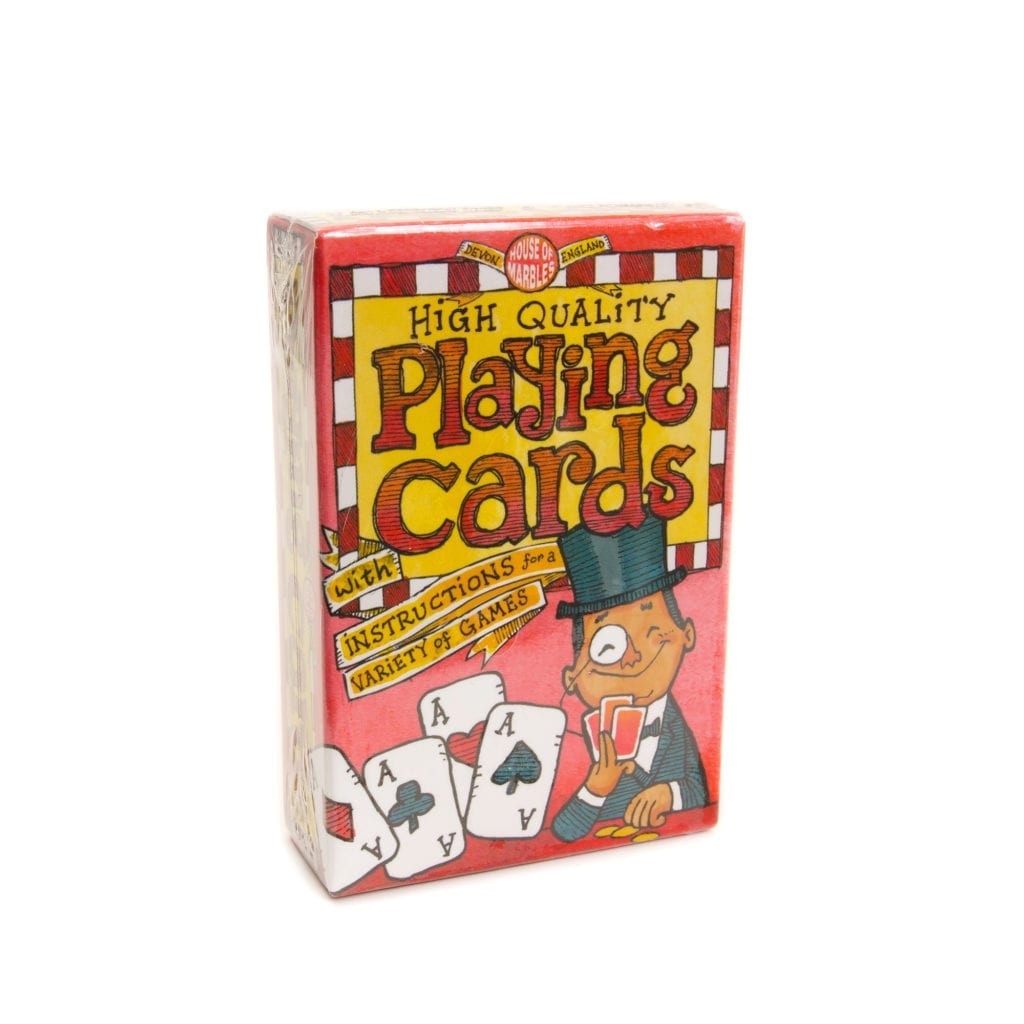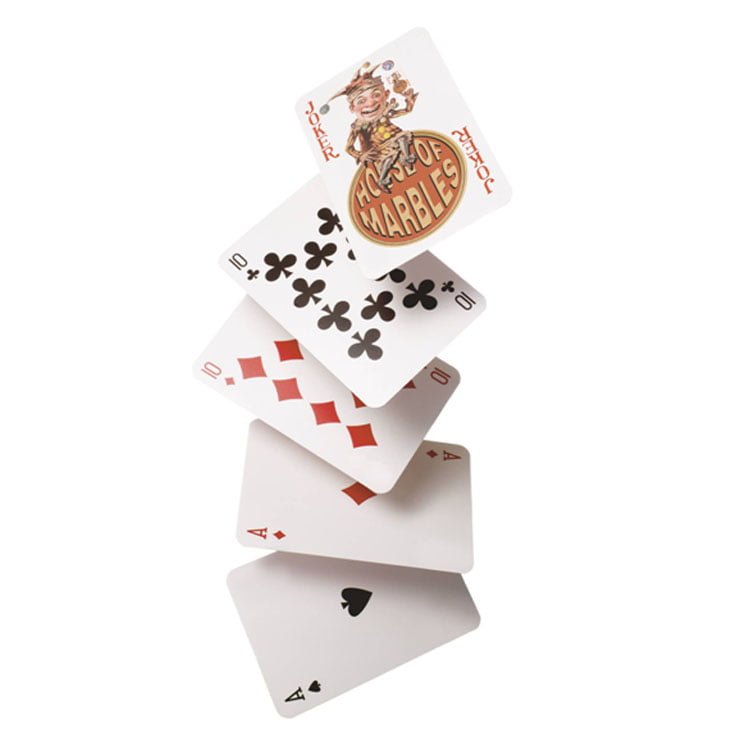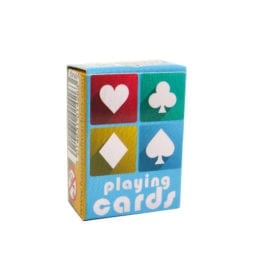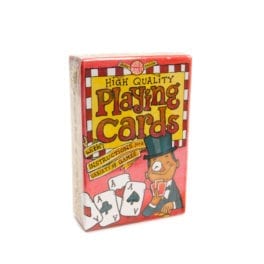Knock Out Whist
This is a simple Whist game for children for two to seven players. Use a standard pack of cards and deal seven cards to each player. The remaining cards are placed face down in a pile in the centre. The top card in this pile is turned up, and this gives a trump suit for the first hand. Play now begins. The aim is to win all the tricks. The person on the left of the dealer leads with any card. The other players follow and must play the same suit if they can. The person playing the highest value card wins the trick. If a player cannot follow suit, they can win the trick by putting down a card from the trump suit. If they do not have trumps either, they should put down anything (preferably something of low value as they are going to lose the trick anyway). The winner of the trick starts the next trick and soon, until all seven cards have been played. Anyone who hasn’t won a trick is eliminated from the game. The cards are gathered up and shuffled but in the second round the dealer only deals six to each player. In the next round five, then four, three, two and then only one in the end, if the game goes that far. Whoever wins the most tricks in a round chooses trumps for the next hand and leads off. Players who win no tricks drop out on the way and sooner or later one player will win all the tricks in a hand. This player is the overall winner.
Palmanism
An ideal game for any number of young players, this is also a good memory test for adults. If you want to play as a large group, and make it more complicated, try using two or even three packs of cards. Take full packs of cards, including Jokers, shuffle them well, and deal them out, face down, in six rows of nine. The first player turns over two cards so they are face up for all to see. If he turns over two cards of the same value he takes them and turns over another two. He can go on as long as he keeps finding pairs. If his two cards do not match, he should place them face down again, and then the next person takes a turn. The player who has collected the most pairs, once all of the cards have been picked up, is the winner. The person with the best memory and the longest attention span will win.
Brag
This is a very old gambling game which is probably the ancestor of Poker. It doesn’t have to be played with money but it is essential to have counters or matchsticks with which to bet. As ever, there are several variations of the game, but the most common is Three Card Brag. Decide at the start who is to deal and what the maximum stake is to be. Use a full pack of cards.
Three specific cards are known as Braggers: Ace of Diamonds, Jack of Clubs, 9 of Diamonds. These cards are Wild and can be whatever you wish.
Play begins with the dealer putting down a stake. He then deals three cards to each player. Once they have looked at their hands, they must bet on the outcome. They must put out a stake at least as high as the dealer’s to stay in the game. If they have nothing in their hand to give them confidence they may retire. Play goes around the table and back to the dealer. If any player has raised the original stake it is now up to the dealer. If he is confident he has a winning hand he puts down another stake at least as large as the highest stake on the table. Again, players around the table consider their position and confidence. They must retire and forfeit their stake, or put down a matching stake. If the dealer has a bad hand, he too may retire, leaving his stake in the pool. When a player has bet an amount that no one else is prepared to match, the others retire and he takes the pool of tokens. He does not have to reveal his cards, so he could be bluffing and have nothing of any value at all, but still win.
If any or all players want to see a high-bidder’s hand, they must first bet a higher amount and then call to see his hand. At this point all hands are revealed and the best hand takes the kitty. A Hand is valued in the following hierarchy:
- Three of a kind (natural): Ace high, down to 2, no wild cards.
- Three of a kind: including one or more Braggers.
- Two of a kind (natural): Ace high, down to 2, no wild cards.
- Two of a kind, including one or more Braggers.
If two players have similar pairs, the player with the highest third card wins. You need nerves of steel and acting ability for this game.
Black Maria
Although it can be played with more, this game is best played with three players and is considered by many to be one of the very best cards games. Its appeal lies in the fact that the players can practise their skill more in this game than in many others. Remove the 2 of Clubs from a normal pack and play with 51 cards. The aim of the game is to avoid taking tricks which contain any Penalty Cards. These cards and their penalty points are:
Queen of Spades – Black Maria – 13 points
King of Spades – 10 points
Ace of Spades – 7 points
All Hearts each of which carries – 1 penalty point
Shuffle and cut the pack to deal, the lowest cut becoming the dealer. Share out the whole pack equally, face down, to the three players.
Players sort their hands into suits and sequence – Aces high. They then select the three cards they want least in their hands and pass them face down to the player on their right. They may not look at the cards they are receiving until they have chosen and passed the three they are discarding. Play begins with the person on the dealer’s left putting a card face upon the table. The next person to the left must play a card of the same suit if he has one, and the third player must then do the same to complete the trick. If a player has no cards of the right suit, he may discard any card of any other suit. The trick is won by the highest card of the suit of the first card played (the suit of the leading card).The winner of a trick leads with a card to start the next trick. Play continues until all 17 tricks are completed. Each player can then total the penalty points of the cards in the tricks they have won. The player with the least penalties wins the round. Skill can be applied throughout this game in the passing of cards at the beginning and obviously in the play itself. Once you have played it a few times you will begin to appreciate all the options for cunning play.
Chase The Face
Each player starts with three counters which represent his three lives. The object of the game is to make sure you are not the one holding the lowest value card in each round. If you are, you surrender a counter and lose a life. When you have lost all three lives you are out. The winner is the person who remains holding one or more counters when all other players have lost their lives. The ranking of cards is as follows: Ace is the lowest value and King the highest. Clubs rank lowest in suit, followed by Diamonds, then Hearts, and Spades have the highest value (therefore, the Ace of Clubs is the lowest possible ranking card and the King of Spades is the highest.) The dealer deals one card face down to each player, who may look at their card. Any player who has a king reveals it by turning it face upon the table. Beginning with the player on the dealer’s left, each player who hasn’t got a King may swap his undisclosed card with that of the player on his left (unless that player has a King).This option is also available to the person the on the dealer’s right. Once every player has decided to keep their card or has exercised their option to risk exchanging it, then the dealer may consider his move. He may keep his card or cut one from the pack. Whichever he does, all cards are now revealed and the person with the lowest loses a life and surrenders a counter. Each round continues in the same way. The cards are shuffled after each hand and the deal moves to the next player on the left.
Pontoon
Also called 21 or Vingt-et-Un, this is probably the most popular and simple of card games for a group of players. First, choose the Banker by making each player take a card from the pack. The person with the highest gets the Bank. This is not always an advantage since an experienced player who bets high can cripple the Bank quickly if he is lucky. For this reason it is a good idea to decide on a maximum stake at the outset of the game. The Banker starts by dealing one card to each player including himself. The players look at their cards and place a bet on the table before them. The Banker then deals each a second card. The aim is to have a hand with a total value as close to 21 as possible, or a hand of five cards with a value of 21 or less. Court cards are all valued as 10. Aces can count as 1 or 11, as the player wishes. All other cards are according to their face value. A pair consisting of an Ace and a 10 or Court card is an instant winner: the cards add up to 21 exactly and should be shown face upon the table at once. This is known as a Pontoon.
The other players keep their cards a secret to themselves. Starting with the person on his left, the Banker asks each person what they wish to do. Their options are as follows: * A player can buy a card by putting out more counters at least equal to (but not more than twice) his original stake. A card that is bought is delivered face DOWN by the Banker. * The player may decide to Twist-ask the Banker to turn over a new card-in which case there is no charge but the card is delivered face up.. * The player can Buy or Twist as he wishes once, twice or three times. However, once a card has been twisted a player cannot return to buying cards. Any player with five cards which total 21 or less has a Five Card Trick. When a player is satisfied with his hand he Sticks and the Banker moves to the next player. * However, if a card brings the player’s hand to a total value above 21 he is Bust and this must be announced. The cards are turned face up and the Banker takes the player’s stake. Once everyone has gone bust, stuck or got a Pontoon, the Banker plays his own hand. The Banker turns up both his cards and can twist to add more cards if he wishes. Once the Bank has decided to stick (or Stay), or has gone Bust, all remaining hands are revealed. If the Bank goes Bust, it must pay out an amount equal to the original stake to anyone who has not gone bust. (Triple to anyone with a Pontoon, Double for a Five Card Trick or 21.) If the Bank sticks on four cards or less, he pays out to anyone with a higher value hand and takes the stake of anyone with a lower value hand. If the Bank has a Five Card Trick he pays out to Pontoons only. Everyone else loses their stake. For instance, the Bank starts with a King and a 1. It turns another card, a 7, bringing its total to 19. It would be prudent to stop at this point, as it would be extremely unlikely to be dealt another 2 or an Ace and anything else would bust the hand. Consequently, the Banker announces that he will “pay20andup”.The Bank sticks and pays an amount equal to the player’s stake to anyone with 20, double the stake to a player with 21, double to anyone with a Five Card Trick, and three times to a Pontoon.
Three times the stake for pontoon.
Twice the stake for five cards of 21 or under in value.
Twice the stake for any cards adding to 21.
Once for any cards adding to 20.





